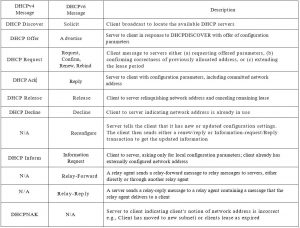DHCP
DHCP Request/Reply Messages a device that already has an IP address can use the simple request/reply exchange Message to get other configuration parameters from a DHCP server. When the DHCP client receives a DHCP offer, the client immediately responds by sending back a DHCP request packet. Devices that aren’t using DHCP to accumulate IP addresses can still utilize DHCP’s other configuration capabilities. A client can broadcast a DHCP INFORM message to request that any available server send its parameters on the usage of the network. DHCP servers respond with the requested parameters and/or default parameters carried in DHCP options of a DHCP ACK message.
Related Product:- Certified Ethical Hacker | CEH Certification
If a DHCP request comes from a hardware address that’s within the DHCP server’s reserved pool and therefore the request isn’t for the IP address that this DHCP server offered, the DHCP server’s offer is invalid. The DHCP server can put that IP address back to the pool and offer it to a different client . In this ways the DHCP Request/Reply Messages going on.

Also Read:- How Dynamic Host Configuration Protocol (DHCP) Works
Questions related to this topic
- How does a client receive an address from a DHCP server?
- What is the source address of a Dhcprequest message?
- What are the four types of messages used in DHCP?
- What is a DHCP request?
Learn CEH & Think like hacker
- What is Ethical Hacking? & Types of Hacking
- 5 Phases of Hacking
- 8 Most Common Types of Hacker Motivations
- What are different types of attacks on a system
- Scope and Limitations of Ethical Hacking
- TEN Different Types Of Hackers
- What is the Foot-printing?
- Top 12 steps for Foot printing Penetration Testing
- Different types of tools with Email Foot printing
- What is “Anonymizer” & Types of Anonymizers
- Top DNS Interrogation Tools
- What is SNMP Enumeration?
- Top vulnerability scanning tools
- Information Security of Threat
- Foot printing tools:
- What is Enumeration?
- Network Security Controls
- What is Identity and Access Management?
- OWASP high TEN web application security risks
- Password Attacks
- Defend Against Key loggers
- Defend Against Spyware
- Covering Tracks
- Covering Track on Networks
- Everything You Need To Know About Sniffing – Part 1
- Everything You Need To Know About Sniffing – Part 2
- Learn more about GPS Spyware & Apparatuses
- Introduction of USB Spyware and It’s types
- 10 Types of Identity Theft You Should Know About
- Concepts of Denial-of-Service Attack & Distributed Denial of Service Attack
- Most Effective Ways to Overcome Impersonation on Social Networking Site’s Problem
- How Dynamic Host Configuration Protocol (DHCP) Works
- DHCP Request/Reply Messages
- DHCP Starvation Attack
- Rogue DHCP Server Attack
- IOS Switch Commands
- Web Server Concept
- Web Server Attacks
- Web Server Attack Tools
- Web Server Security Tools
- 6 Quick Methodology For Web Server Attack
- Learn Skills From Web Server Foot Printing / Banner Grapping
- The 10 Secrets You Will Never Know About Cyber Security And Its Important?
- Ways To Learn Finding Default Content Of Web Server Effectively
- How will Social Engineering be in the Future
- Understand The Background Of Top 9 Challenges IT Leaders Will Face In 2020 Now
- Learning Good Ways To Protect Yourself From Identity Theft
- Anti-phishing Tools Guide
This Blog Article is posted by
Infosavvy, 2nd Floor, Sai Niketan, Chandavalkar Road Opp. Gora Gandhi Hotel, Above Jumbo King, beside Speakwell Institute, Borivali West, Mumbai, Maharashtra 400092
Contact us – www.info-savvy.com



